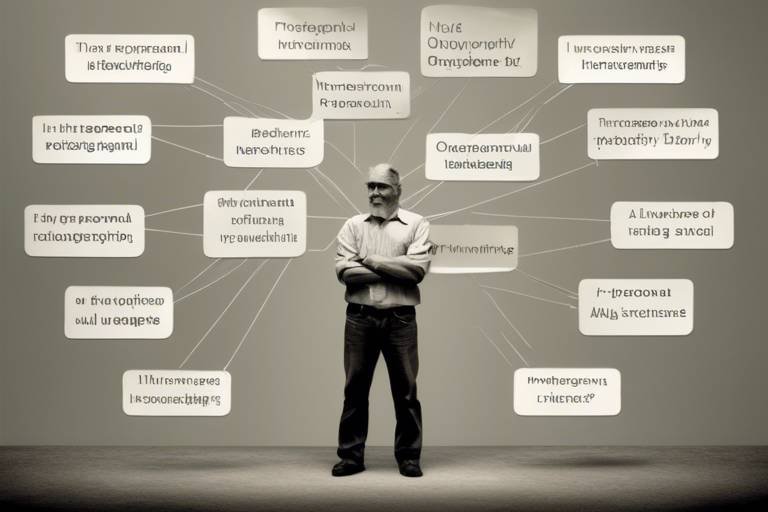Ontology in Computer Science - An Overview
In the ever-evolving world of technology, the term ontology often pops up, especially in discussions surrounding artificial intelligence and information systems. But what exactly does it mean? At its core, ontology is a formal representation of knowledge that organizes concepts within a specific domain and outlines the relationships between those concepts. Imagine it as a well-structured map of ideas, helping both humans and machines navigate the complex landscape of information. This structured approach not only facilitates better information sharing but also enhances understanding across different computer systems.
The significance of ontology extends far beyond mere organization. In computer science, ontologies serve as a foundation for building intelligent systems that can reason and understand data in a way that mimics human cognition. They enable machines to process information more effectively, which is especially crucial in areas like natural language processing and semantic web technologies. Think of ontologies as the backbone of AI, providing the necessary structure for machines to interpret and utilize data meaningfully.
Furthermore, the applications of ontologies are vast and varied. From enhancing knowledge management in organizations to improving bioinformatics research, ontologies play a pivotal role in ensuring that data is not only organized but also accessible and understandable. They enable interoperability among different systems, allowing for seamless integration and communication. This interoperability is essential in today’s data-driven world, where information can come from myriad sources and needs to be synthesized into coherent knowledge.
As we delve deeper into the realm of ontologies, it becomes clear that they are not just theoretical constructs. They are practical tools that address real-world challenges in knowledge representation and information retrieval. However, developing ontologies is not without its challenges. Issues such as ensuring consistency, managing complexity, and adapting to the dynamic nature of knowledge require careful consideration and ongoing maintenance.
Looking ahead, the future of ontologies is promising. With advancements in machine learning, big data, and the Internet of Things, the role of ontologies is expected to expand, driving innovation in how we represent and interact with knowledge. As technology continues to evolve, so too will the methodologies and frameworks we use to create and implement ontologies, ensuring they remain relevant and effective in meeting the demands of a rapidly changing landscape.
- What is the primary purpose of an ontology in computer science?
The primary purpose of ontology in computer science is to provide a structured framework for organizing knowledge, which facilitates better information sharing and understanding among systems. - How do ontologies impact artificial intelligence?
Ontologies impact artificial intelligence by enabling machines to process and understand information more effectively, which is crucial for tasks like natural language processing and reasoning. - What are the different types of ontologies?
The different types of ontologies include upper ontologies, domain ontologies, and task ontologies, each serving specific purposes and levels of abstraction. - What challenges do developers face when creating ontologies?
Developers face challenges such as ensuring consistency, managing complexity, and keeping up with the dynamic nature of knowledge during ontology development.

What is Ontology?
This article explores the concept of ontology in computer science, its significance, applications, and the various methodologies used in its development and implementation in information systems.
Ontology, in the realm of computer science, refers to a formal representation of knowledge that encompasses a set of concepts within a specific domain, along with the relationships that exist between those concepts. Imagine it as a map of knowledge that helps us navigate through complex information landscapes. By structuring knowledge in this way, ontologies facilitate better information sharing and understanding among computer systems, much like a common language allows people from different backgrounds to communicate effectively.
At its core, ontology serves as a framework that defines the entities, properties, and relationships in a particular domain. This representation is crucial for enabling computers to interpret and process information in a manner that mimics human understanding. For example, in a healthcare setting, an ontology might define relationships between patients, diseases, treatments, and healthcare providers, creating a structured environment for data management and analysis.
To illustrate the components of ontology, consider the following table:
| Component | Description |
|---|---|
| Classes | Categories or types of things within the domain. |
| Instances | Specific examples of classes. |
| Properties | Attributes or characteristics of the classes. |
| Relations | Connections between classes and instances. |
In practice, ontologies are not just theoretical constructs; they are applied in various domains to enhance data interoperability and facilitate knowledge sharing. For instance, in the world of e-commerce, an ontology can help different systems understand product categories, pricing, and customer preferences, thereby improving the shopping experience.
Furthermore, ontologies can also support advanced applications such as artificial intelligence and machine learning. By providing a structured framework for knowledge representation, they enable machines to make inferences, reason about data, and even engage in natural language processing tasks. This is akin to equipping a robot with a comprehensive manual that allows it to understand and interact with its environment intelligently.
In summary, ontology is a powerful tool in computer science that bridges the gap between human knowledge and machine understanding. Through its structured representation of concepts and relationships, it plays a pivotal role in enhancing communication, interoperability, and intelligent reasoning across various information systems.
In artificial intelligence, ontologies provide a structured framework for knowledge representation, enabling machines to understand and process information more effectively, which is crucial for natural language processing and reasoning tasks.
Ontologies can be categorized into several types, including upper ontologies, domain ontologies, and task ontologies, each serving different purposes and levels of abstraction in knowledge representation.
Upper ontologies provide a high-level framework that includes general concepts applicable across various domains, facilitating interoperability and knowledge sharing among different systems and applications.
Domain ontologies are specialized representations focused on a specific area of knowledge, detailing the concepts and relationships pertinent to that domain, enhancing clarity and precision in data representation.
Various methodologies exist for developing ontologies, including top-down, bottom-up, and middle-out approaches, each offering unique advantages depending on the specific requirements and context of the ontology being created.
The top-down approach involves starting with a high-level ontology and refining it into more specific concepts, allowing for a comprehensive structure that can be adapted to various applications.
In contrast, the bottom-up approach begins with specific instances and builds up to broader concepts, enabling the ontology to evolve organically based on real-world data and use cases.
Ontologies are widely used in various fields, including semantic web technologies, knowledge management, bioinformatics, and information retrieval, enhancing data interoperability and enabling more intelligent systems.
Developing ontologies poses several challenges, including ensuring consistency, managing complexity, and addressing the dynamic nature of knowledge, which requires ongoing maintenance and updates to remain relevant.
As technology advances, the role of ontologies in areas like machine learning, big data, and the Internet of Things is expected to grow, driving innovation in knowledge representation and information systems.
- What is the main purpose of an ontology? Ontologies aim to provide a structured representation of knowledge that facilitates better understanding and sharing of information across systems.
- How are ontologies used in artificial intelligence? Ontologies enable machines to process and understand information more effectively, which is essential for tasks like natural language processing and reasoning.
- What are some common types of ontologies? Common types include upper ontologies, domain ontologies, and task ontologies, each serving unique purposes in knowledge representation.

Importance of Ontology in AI
When it comes to artificial intelligence, the term ontology might not be the first thing that pops into your mind. However, it's a cornerstone that supports the entire structure of knowledge representation in AI. Think of ontology as the backbone of a library; without it, finding the right books (or in this case, information) would be a chaotic mess. In essence, ontologies provide a structured framework that helps machines understand and process information more effectively. This is crucial for tasks like natural language processing and reasoning, where the ability to interpret and manipulate data accurately can make or break an AI system.
Imagine trying to have a conversation with someone who speaks a different language. You might share some words, but without a common understanding of the context, the conversation could quickly become nonsensical. This is where ontologies come into play. They establish a shared vocabulary and a set of relationships between concepts that allow AI systems to communicate and reason about knowledge in a meaningful way. For instance, in natural language processing, ontologies can help in disambiguating words that have multiple meanings based on their context, allowing the AI to deliver more accurate results.
Moreover, ontologies facilitate interoperability among different AI systems. When multiple systems can understand the same concepts and their interrelations, they can work together seamlessly. This is particularly important in fields like healthcare, where various AI applications need to share and interpret patient data consistently. By using a common ontology, these systems can ensure that the information exchanged is understood correctly, leading to better decision-making and outcomes.
Another significant aspect of ontology in AI is its role in enhancing machine learning. When training AI models, having a well-defined ontology allows for better feature extraction and representation. Instead of feeding raw data into a model, you can provide structured information that highlights the relevant relationships and hierarchies. This not only improves the accuracy of the model but also speeds up the learning process. In a world where data is exploding at an unprecedented rate, the efficiency gained through ontologies can be a game-changer.
In summary, the importance of ontology in AI cannot be overstated. It serves as the foundation for knowledge representation, enabling machines to understand and process information in a structured way. From enhancing natural language processing capabilities to facilitating interoperability among systems, ontologies are essential for the advancement of AI technologies. As we move forward, their role will only become more pronounced, driving innovation and improving the effectiveness of intelligent systems.
- What is the main purpose of ontology in AI? Ontology in AI provides a structured framework for knowledge representation, enabling machines to understand, process, and reason about information effectively.
- How does ontology improve natural language processing? By establishing a shared vocabulary and relationships between concepts, ontologies help disambiguate words and enhance context understanding, leading to more accurate results.
- Can ontologies facilitate interoperability among AI systems? Yes, ontologies allow different AI systems to communicate and share information seamlessly by using a common understanding of concepts.
- What role do ontologies play in machine learning? They enhance feature extraction and representation, improving model accuracy and speeding up the learning process.

Types of Ontologies
When diving into the world of ontologies, it’s essential to understand that they aren't all cut from the same cloth. Different types of ontologies serve various purposes, each tailored to specific needs and contexts. Think of ontologies as different types of maps; while some provide a broad overview of a region, others focus on intricate details of a particular city. Here, we will explore the major categories of ontologies, which include upper ontologies, domain ontologies, and task ontologies.
Upper ontologies act as the foundation of knowledge representation. They offer a high-level framework that encompasses general concepts applicable across multiple domains. This broad perspective is vital for achieving interoperability among different systems and applications. Imagine you’re trying to navigate through various software programs that handle data differently; upper ontologies create a common language that allows these systems to communicate effectively. For example, an upper ontology might define what a "vehicle" is, which can then be used across systems dealing with transportation, logistics, or even gaming.
On the other hand, we have domain ontologies, which are like specialized maps that focus on a particular area of knowledge. These ontologies provide detailed representations of concepts and relationships relevant to specific fields, enhancing clarity and precision in data representation. For instance, in the medical field, a domain ontology might outline the relationships between diseases, symptoms, and treatments, making it easier for healthcare professionals to access and share critical information. This specificity not only improves understanding but also facilitates better data management and retrieval.
Additionally, there are task ontologies, which are designed to support specific tasks or activities within a domain. They provide the necessary context and structure to enable systems to carry out particular functions effectively. For example, in a software application focused on customer service, a task ontology might define the various interactions between customers and service agents, detailing the steps involved in resolving issues. This structured approach ensures that the system can guide users through complex processes seamlessly.
In summary, the types of ontologies can be categorized as follows:
| Type of Ontology | Description | Example |
|---|---|---|
| Upper Ontologies | High-level frameworks applicable across various domains. | General concepts like "Vehicle" or "Location." |
| Domain Ontologies | Specialized representations focused on a specific area of knowledge. | Medical ontologies detailing diseases and treatments. |
| Task Ontologies | Ontologies that support specific tasks or activities within a domain. | Customer service interactions and processes. |
Understanding these types of ontologies is crucial for anyone looking to harness the power of knowledge representation in computer science. By utilizing the right type of ontology, organizations can improve data interoperability, enhance communication between systems, and ultimately create more intelligent applications that meet user needs effectively.
- What is the main purpose of ontologies? Ontologies help in structuring knowledge, making it easier for machines and humans to share and understand information.
- How do ontologies improve artificial intelligence? They provide a structured framework for knowledge representation, enabling machines to process information more effectively.
- Can ontologies evolve over time? Yes, ontologies can and should be updated to reflect the dynamic nature of knowledge and information.
- What are some common applications of ontologies? They are used in semantic web technologies, knowledge management, bioinformatics, and information retrieval.

Upper Ontologies
Upper ontologies serve as a foundational framework in the realm of knowledge representation, acting like a scaffold that supports a wide array of specific concepts across various domains. Imagine them as the skeleton of a body, providing structure and form that allows for the integration and interoperability of diverse systems. These ontologies consist of high-level categories that encapsulate general concepts which can be universally applied, facilitating a shared understanding among different applications and systems.
One of the significant advantages of upper ontologies is their ability to promote interoperability. In a world where data comes from myriad sources—think social media, scientific databases, and corporate information systems—having a common conceptual framework is invaluable. This commonality allows disparate systems to communicate effectively, reducing the ambiguity that often arises from varied terminologies and classifications.
For instance, consider the upper ontology of “Living Being.” This category can include various subclasses such as “Animal,” “Plant,” and “Fungi,” each of which can further branch into more specific categories. This hierarchical structure not only organizes knowledge but also enhances the ability to draw inferences and make connections between different domains.
The development of upper ontologies often involves collaboration among experts from various fields to ensure that the concepts included are comprehensive and applicable across different scenarios. The following table illustrates some key characteristics of upper ontologies:
| Characteristic | Description |
|---|---|
| Generalization | Upper ontologies encapsulate broad concepts that can apply to multiple domains. |
| Interoperability | They facilitate communication and integration among different systems. |
| Scalability | These ontologies can be expanded or refined as new knowledge emerges. |
| Consistency | They help maintain a uniform understanding of concepts across various applications. |
In summary, upper ontologies are not just abstract concepts; they are practical tools that enhance our ability to organize, share, and utilize knowledge effectively. As technology evolves, the importance of upper ontologies will only continue to grow, paving the way for more intelligent and interconnected systems. The challenge remains, however, in ensuring that these ontologies are kept up-to-date and relevant in a rapidly changing knowledge landscape.

Domain Ontologies
Domain ontologies are specialized frameworks that focus on a specific area of knowledge, providing a detailed representation of concepts and their interrelations within that domain. Imagine trying to navigate a vast library without a catalog; it would be overwhelming and inefficient. Domain ontologies act as that catalog, organizing knowledge in a way that makes it accessible and understandable. They enhance clarity and precision in data representation, ensuring that both humans and machines can interpret the information accurately.
One of the key features of domain ontologies is their ability to define the vocabulary and relationships pertinent to a specific field. For instance, in the medical domain, a domain ontology might include terms like "disease," "symptom," and "treatment," along with the relationships between these concepts. This structured approach not only aids in information retrieval but also facilitates better communication among professionals in the field. With a well-defined ontology, healthcare providers can ensure that they are speaking the same language, reducing misunderstandings and improving patient care.
Additionally, domain ontologies play a vital role in knowledge management systems. They allow organizations to capture and share knowledge effectively, making it easier to transfer expertise across different teams and departments. By using domain ontologies, companies can create a shared understanding of their core concepts, which is crucial for collaboration and innovation. Furthermore, these ontologies can be updated as new knowledge emerges, ensuring that they remain relevant in a constantly evolving landscape.
To illustrate the importance of domain ontologies, consider the following table that outlines some common applications across various fields:
| Field | Domain Ontology Example | Purpose |
|---|---|---|
| Healthcare | SNOMED CT | Standardized terminology for clinical terms |
| Biology | Gene Ontology | Describes gene functions across species |
| Finance | Financial Industry Business Ontology (FIBO) | Models financial instruments and their relationships |
| Education | Learning Resource Metadata Initiative (LRMI) | Describes educational resources and their attributes |
In conclusion, domain ontologies serve as the backbone of knowledge representation in specific areas, facilitating better data management, interoperability, and communication. As industries continue to evolve, the development and refinement of these ontologies will be crucial in ensuring that knowledge remains accessible and applicable. The precision they offer allows for more intelligent systems that can leverage data effectively, ultimately leading to improved decision-making and innovation.

Ontology Development Methodologies
When it comes to developing ontologies, there isn't a one-size-fits-all approach. Instead, various methodologies exist, each tailored to suit different needs and contexts. These methodologies can be broadly categorized into three main approaches: top-down, bottom-up, and middle-out. Understanding these approaches is crucial for anyone looking to create effective and functional ontologies that can serve their intended purpose.
The top-down approach is like building a skyscraper. You start with a grand vision of the structure, outlining the main framework before filling in the details. In this case, you begin with a high-level ontology that encompasses broad concepts and categories. From there, you refine these categories into more specific concepts. This method allows for a comprehensive structure that can be adapted to various applications, making it particularly useful for projects that require a unified view across multiple domains. However, it can also lead to challenges in ensuring that the high-level concepts are relevant and applicable to all the specific cases they aim to cover.
On the flip side, the bottom-up approach takes a more organic route. Imagine starting with a collection of unique pieces of art and gradually curating them into a cohesive gallery. This approach begins with specific instances or data points and builds up to broader concepts. This method is beneficial because it allows the ontology to evolve based on real-world data and use cases, making it highly relevant and tailored to the needs of its users. However, it can lead to inconsistencies if not carefully managed, as the initial data points might not always align perfectly with broader concepts that emerge later.
Then there’s the middle-out approach, which serves as a bridge between the two. This method involves starting with a mid-level ontology that captures some general concepts while also allowing for the incorporation of specific instances. This flexibility can be particularly advantageous in dynamic environments where both high-level and detailed knowledge are essential. By balancing the strengths of both top-down and bottom-up approaches, the middle-out methodology can adapt to changes in knowledge and requirements more fluidly.
Each of these methodologies comes with its own set of advantages and challenges. The choice of which approach to use often depends on factors such as the scope of the project, the complexity of the domain, and the resources available for ontology development. To help illustrate these differences, here's a quick comparison:
| Approach | Advantages | Challenges |
|---|---|---|
| Top-Down | Comprehensive structure, broad applicability | Risk of irrelevance, potential oversimplification |
| Bottom-Up | Highly relevant, data-driven | Potential inconsistencies, may lack a cohesive structure |
| Middle-Out | Flexibility, balance of high-level and specific knowledge | Can be complex to manage, requires careful integration |
In conclusion, the methodology you choose for ontology development can significantly impact the effectiveness and usability of the resulting ontology. Whether you lean towards a top-down, bottom-up, or middle-out approach, it's essential to consider the specific needs of your project and the characteristics of the domain you're working in. This thoughtful approach will not only enhance the ontology's performance but also ensure it remains relevant and useful over time.
- What is ontology in computer science?
Ontology is a formal representation of knowledge as a set of concepts within a domain and the relationships between those concepts, facilitating better information sharing and understanding. - Why is ontology important in artificial intelligence?
Ontologies provide a structured framework for knowledge representation, enabling machines to understand and process information more effectively, which is crucial for tasks like natural language processing. - What are the different types of ontologies?
Ontologies can be categorized into upper ontologies, domain ontologies, and task ontologies, each serving different purposes and levels of abstraction. - What challenges are faced in ontology development?
Some challenges include ensuring consistency, managing complexity, and addressing the dynamic nature of knowledge, which requires ongoing maintenance. - What are the future trends in ontology development?
As technology advances, ontologies are expected to play a larger role in areas like machine learning, big data, and the Internet of Things.

Top-Down Approach
The to ontology development is akin to constructing a skyscraper. You start with a robust foundation—a high-level ontology that outlines broad concepts and categories relevant to a particular domain. From this solid base, you gradually refine and expand into more specific concepts that fill in the details. This method is particularly beneficial because it provides a comprehensive structure that can be adapted to various applications, ensuring that the ontology remains relevant and useful across different contexts.
One of the primary advantages of the top-down approach is its ability to promote interoperability. By establishing a high-level framework, different systems can communicate more effectively, sharing knowledge and data without confusion. For instance, if multiple organizations adopt the same upper ontology, they can seamlessly exchange information, greatly enhancing collaboration and efficiency. This is especially important in fields like healthcare, where different institutions need to share patient data while maintaining privacy and security standards.
Moreover, the top-down approach allows for a greater degree of control over the structure of the ontology. Developers can ensure that all necessary concepts are included from the outset, reducing the likelihood of gaps in knowledge representation. However, this method also has its challenges. It requires a thorough understanding of the domain to develop a comprehensive high-level ontology. Additionally, if the initial framework is too rigid, it may stifle the incorporation of new concepts that emerge over time.
To illustrate the top-down approach, consider the following example of developing an ontology for an e-commerce platform:
| Level | Concepts | Description |
|---|---|---|
| 1 | Product | The broad category encompassing all items available for sale. |
| 2 | Electronics | A subcategory of products specifically related to electronic devices. |
| 3 | Mobile Phones | A more specific category under electronics, detailing various types of mobile devices. |
| 4 | Smartphones | A specific type of mobile phone that includes advanced features and capabilities. |
In this example, the ontology begins with a broad concept of "Product," which is then broken down into increasingly specific categories. This hierarchical structure not only makes it easier for users to navigate the e-commerce platform but also enhances the effectiveness of search algorithms, allowing for more accurate product recommendations.
In conclusion, while the top-down approach provides a structured and organized way to develop ontologies, it requires careful planning and a deep understanding of the domain. As technology evolves and new concepts emerge, maintaining flexibility within the ontology is crucial for its long-term success. By balancing structure with adaptability, developers can create ontologies that not only serve current needs but also anticipate future developments in their respective fields.
- What is the main advantage of the top-down approach?
It provides a structured framework that promotes interoperability and ensures comprehensive coverage of concepts. - How does the top-down approach differ from the bottom-up approach?
The top-down approach starts with high-level concepts and refines them, while the bottom-up approach begins with specific data and builds up to broader concepts. - Can the top-down approach be used in all domains?
While it is applicable in many domains, the effectiveness depends on the complexity and variability of the knowledge within that domain.

Bottom-Up Approach
The to ontology development is a fascinating method that emphasizes the importance of real-world data and specific instances. Instead of starting with a broad, high-level framework, this approach begins with concrete examples and gradually builds up to more generalized concepts. Imagine constructing a house: you wouldn’t start by designing the roof; instead, you’d lay down the foundation and build the walls first. This analogy perfectly illustrates the essence of the bottom-up approach in ontology development.
One of the primary advantages of this method is its ability to evolve organically. As new data is introduced, the ontology can adapt and expand, ensuring that it remains relevant and reflective of the actual domain it represents. This adaptability is crucial in fields where knowledge is continuously changing, such as healthcare or technology. For instance, in bioinformatics, researchers often encounter new species or genetic information that requires immediate incorporation into existing ontologies. A bottom-up approach allows for this seamless integration.
However, the bottom-up approach is not without its challenges. As the ontology grows, maintaining coherence and consistency becomes increasingly complex. The relationships between concepts must be carefully defined to avoid confusion. For example, if we consider a biological ontology, one must ensure that the terms used for various species are not only accurate but also clearly delineated from one another. This requires a meticulous effort to document and manage the evolving structure.
Moreover, the bottom-up approach can lead to a proliferation of terms and definitions, which, while beneficial in terms of specificity, can also result in an unwieldy ontology. To counteract this potential drawback, it’s essential to establish clear guidelines for how new concepts are integrated. This might involve:
- Regular reviews of existing terms
- Establishing a governance model for ontology updates
- Encouraging collaboration among domain experts
In conclusion, the bottom-up approach to ontology development offers a dynamic and responsive framework that can accurately reflect the complexities of a specific domain. By prioritizing real-world data and fostering adaptability, this method provides a robust foundation for building ontologies that are not only useful but also sustainable over time. As we continue to delve deeper into various fields, embracing this approach will likely yield richer, more nuanced representations of knowledge.

Applications of Ontologies
Ontologies have become a vital component in various fields, enhancing the way we process, share, and understand information. Their structured frameworks allow for a more organized representation of knowledge, which is essential in today's data-driven world. One of the most notable applications of ontologies is in semantic web technologies. By providing a common vocabulary, ontologies enable different systems to communicate seamlessly, leading to improved data interoperability. Imagine trying to have a conversation with someone who speaks a different language; without a shared vocabulary, it becomes almost impossible to convey ideas. Similarly, ontologies bridge the gap between disparate systems, allowing them to share and understand information efficiently.
Another significant area where ontologies play a crucial role is in knowledge management. Organizations are inundated with vast amounts of data, and ontologies help categorize and structure this information. By defining relationships between various concepts, ontologies facilitate better decision-making processes and enhance organizational learning. For instance, a company might use a domain ontology to organize its internal knowledge base, making it easier for employees to find relevant information quickly. This is akin to having a well-organized library where every book has its place; it saves time and effort in locating the right material.
In the realm of bioinformatics, ontologies are indispensable for managing biological data. They provide a standardized way to represent complex biological concepts and their interrelations, which is crucial for research and analysis. For example, the Gene Ontology (GO) is widely used to describe gene functions consistently across different species. This uniformity allows researchers to share findings and collaborate effectively, much like how a universal language fosters international dialogue.
Furthermore, ontologies are instrumental in enhancing information retrieval systems. By enabling more precise queries and improving the relevance of search results, ontologies ensure that users can find the information they need quickly and accurately. This capability is particularly beneficial in fields like healthcare, where timely access to information can significantly impact patient outcomes. Think of it as having a personal assistant who knows exactly what you need and can fetch it for you in an instant.
In addition to these applications, ontologies are increasingly being integrated into emerging technologies such as artificial intelligence and the Internet of Things (IoT). They provide the foundational structure necessary for machines to understand and process data in a way that mimics human reasoning. As AI continues to evolve, the role of ontologies in enabling intelligent systems will only become more pronounced, paving the way for innovations that we can only begin to imagine.
| Field | Application of Ontology |
|---|---|
| Semantic Web Technologies | Facilitates data interoperability and communication between systems. |
| Knowledge Management | Helps categorize and structure organizational knowledge for better decision-making. |
| Bioinformatics | Standardizes representation of biological concepts for research. |
| Information Retrieval | Improves search accuracy and relevance of results. |
| Artificial Intelligence | Provides structure for machines to process data intelligently. |
| Internet of Things | Enables smart devices to communicate and understand data. |
- What is an ontology? Ontology is a formal representation of knowledge that defines concepts and relationships within a specific domain.
- How do ontologies enhance data interoperability? By providing a common vocabulary and structure, ontologies allow different systems to share and understand data seamlessly.
- Can ontologies evolve over time? Yes, ontologies can be updated and refined to accommodate new knowledge and changes in specific domains.
- What are some challenges in developing ontologies? Challenges include ensuring consistency, managing complexity, and keeping the ontology relevant as knowledge evolves.

Challenges in Ontology Development
Developing ontologies is no walk in the park; it’s more like navigating a complex maze filled with various challenges that can trip up even the most seasoned developers. One of the primary hurdles is ensuring consistency across the ontology. Imagine trying to build a house with bricks that don’t fit together. If the terms and relationships within the ontology aren’t defined consistently, the entire structure can crumble, leading to misunderstandings and misinterpretations of data. This is especially critical in fields like healthcare or finance, where precise terminology is paramount.
Another major challenge is managing complexity. As the ontology grows, it can become increasingly intricate, making it difficult to maintain. Developers often find themselves in a tug-of-war between adding more detail to improve precision and keeping the ontology manageable. This complexity can lead to performance issues, especially in systems that rely on real-time data processing. The more complex the ontology, the more resources it can consume, which can slow down applications and frustrate users.
Additionally, the dynamic nature of knowledge presents a significant challenge. Knowledge is not static; it evolves over time. New concepts emerge, and existing ones may change in meaning or relevance. This means that ontologies require ongoing maintenance and updates to remain relevant and useful. Developers must establish a robust process for regularly reviewing and revising the ontology, which can be resource-intensive and time-consuming. The need for continuous adaptation can feel like trying to hit a moving target.
To better illustrate these challenges, consider the following table that outlines some common issues faced during ontology development:
| Challenge | Description | Impact |
|---|---|---|
| Consistency | Ensuring uniformity in terms and relationships. | Misinterpretation of data. |
| Complexity | Managing the intricate structure as it grows. | Performance issues in applications. |
| Dynamic Nature | Adapting to evolving knowledge. | Need for ongoing maintenance and updates. |
Moreover, collaboration among stakeholders can also pose challenges. Different teams may have varying priorities, perspectives, and terminologies, leading to conflicts during the ontology development process. It’s crucial to have a common understanding among all parties involved to create an effective ontology. This often requires extensive communication and negotiation, which can be time-consuming.
In summary, while the development of ontologies is essential for enhancing information systems and knowledge representation, it is fraught with challenges. From ensuring consistency and managing complexity to adapting to the dynamic nature of knowledge and fostering collaboration, developers must navigate a landscape filled with potential pitfalls. However, overcoming these challenges can lead to the creation of robust and effective ontologies that significantly enhance data interoperability and system intelligence.
- What is an ontology? An ontology is a formal representation of knowledge, detailing concepts and the relationships between them within a specific domain.
- Why are ontologies important in AI? Ontologies provide a structured framework for knowledge representation, which is crucial for enabling machines to understand and process information effectively.
- What are the main challenges in developing ontologies? Key challenges include ensuring consistency, managing complexity, adapting to the dynamic nature of knowledge, and promoting collaboration among stakeholders.
- How can ontologies be maintained over time? Regular reviews and updates are essential, along with establishing processes for incorporating new knowledge and adjusting existing concepts.

Future Trends in Ontology
As we look ahead, the role of ontologies in technology is poised to expand significantly, particularly in the realms of machine learning, big data, and the Internet of Things (IoT). These advancements are not just buzzwords; they represent a seismic shift in how we manage and interpret vast amounts of data. Imagine a world where machines not only process information but also understand the context behind it. This is where ontologies come into play, acting as the backbone for knowledge representation.
One of the most exciting trends is the integration of ontologies with artificial intelligence. As AI systems become more sophisticated, the need for structured knowledge representation becomes even more crucial. Ontologies can provide the necessary framework for AI to comprehend complex relationships and concepts, allowing for enhanced reasoning capabilities and improved decision-making processes. For instance, in healthcare, ontologies can help AI systems understand patient data more holistically, leading to better diagnosis and treatment plans.
Moreover, the rise of the semantic web is another area where ontologies will shine. As the web evolves into a more interconnected and intelligent space, ontologies will facilitate better data interoperability. This means that different systems can communicate more effectively, sharing knowledge seamlessly across platforms. Picture a scenario where your smart home devices can talk to each other and make decisions based on shared knowledge, all thanks to ontological frameworks.
In addition, the dynamic nature of knowledge means that ontologies will need to be adaptable. This adaptability will be crucial as new information emerges and existing knowledge evolves. Future methodologies for ontology development will likely focus on creating ontologies that can update themselves in real-time, ensuring that they remain relevant and accurate. This could involve leveraging machine learning algorithms to automatically refine and enhance ontological structures based on user interactions and data trends.
Furthermore, the integration of ontologies with big data analytics will enable organizations to extract more meaningful insights from their data. By providing a structured representation of concepts and relationships, ontologies can help data scientists better understand the context behind their data sets, leading to more informed decision-making. For example, in marketing, ontologies can help businesses analyze customer behavior more effectively, tailoring their strategies to meet specific needs.
Lastly, as the Internet of Things continues to grow, the demand for ontologies will likely increase. With countless devices generating data, ontologies can help organize and interpret this information, enabling smarter interactions and automation. Imagine a future where your car, home, and personal devices work together seamlessly, all guided by a shared understanding of your preferences and needs, thanks to ontological frameworks.
- What is an ontology in computer science?
Ontology in computer science is a formal representation of knowledge that defines a set of concepts within a specific domain and the relationships between those concepts. - How do ontologies benefit artificial intelligence?
Ontologies provide a structured framework that allows AI systems to understand and process information more effectively, enhancing their reasoning capabilities. - What are some common applications of ontologies?
Ontologies are used in various fields, including semantic web technologies, knowledge management, bioinformatics, and information retrieval. - What challenges are faced in ontology development?
Challenges include ensuring consistency, managing complexity, and keeping the ontology relevant as knowledge evolves.
Frequently Asked Questions
- What is the main purpose of ontology in computer science?
Ontology serves as a formal representation of knowledge, outlining concepts within a specific domain and the relationships between them. This structure facilitates better information sharing and understanding in computer systems, making it easier for machines to process and interpret data.
- How does ontology enhance artificial intelligence?
In AI, ontologies provide a structured framework for knowledge representation. This is crucial for enabling machines to understand and process information effectively, particularly in tasks related to natural language processing and reasoning. Think of it as giving AI a map to navigate the vast landscape of information.
- What are the different types of ontologies?
Ontologies can be categorized into upper ontologies, domain ontologies, and task ontologies. Upper ontologies offer a high-level framework applicable across various domains, while domain ontologies focus on specific areas of knowledge. Task ontologies define concepts related to particular tasks, making them versatile in knowledge representation.
- What methodologies are used for developing ontologies?
There are several methodologies for ontology development, including top-down, bottom-up, and middle-out approaches. The top-down approach starts with a broad framework and refines it into specific concepts, while the bottom-up approach begins with specific instances and builds up. The middle-out approach combines elements of both, providing flexibility based on project needs.
- Can you give examples of ontology applications?
Ontologies are widely used in fields like semantic web technologies, knowledge management, bioinformatics, and information retrieval. They enhance data interoperability, enabling systems to communicate more efficiently and intelligently, which is essential in today's data-driven world.
- What challenges are faced in ontology development?
Developing ontologies can be challenging due to the need for consistency, managing complexity, and addressing the dynamic nature of knowledge. As new information emerges, ontologies require ongoing maintenance and updates to stay relevant, which can be a significant undertaking.
- What are the future trends in ontology?
Looking ahead, the role of ontologies is expected to grow in areas like machine learning, big data, and the Internet of Things. As technology evolves, ontologies will play a critical role in driving innovation in knowledge representation and enhancing the capabilities of information systems.



















